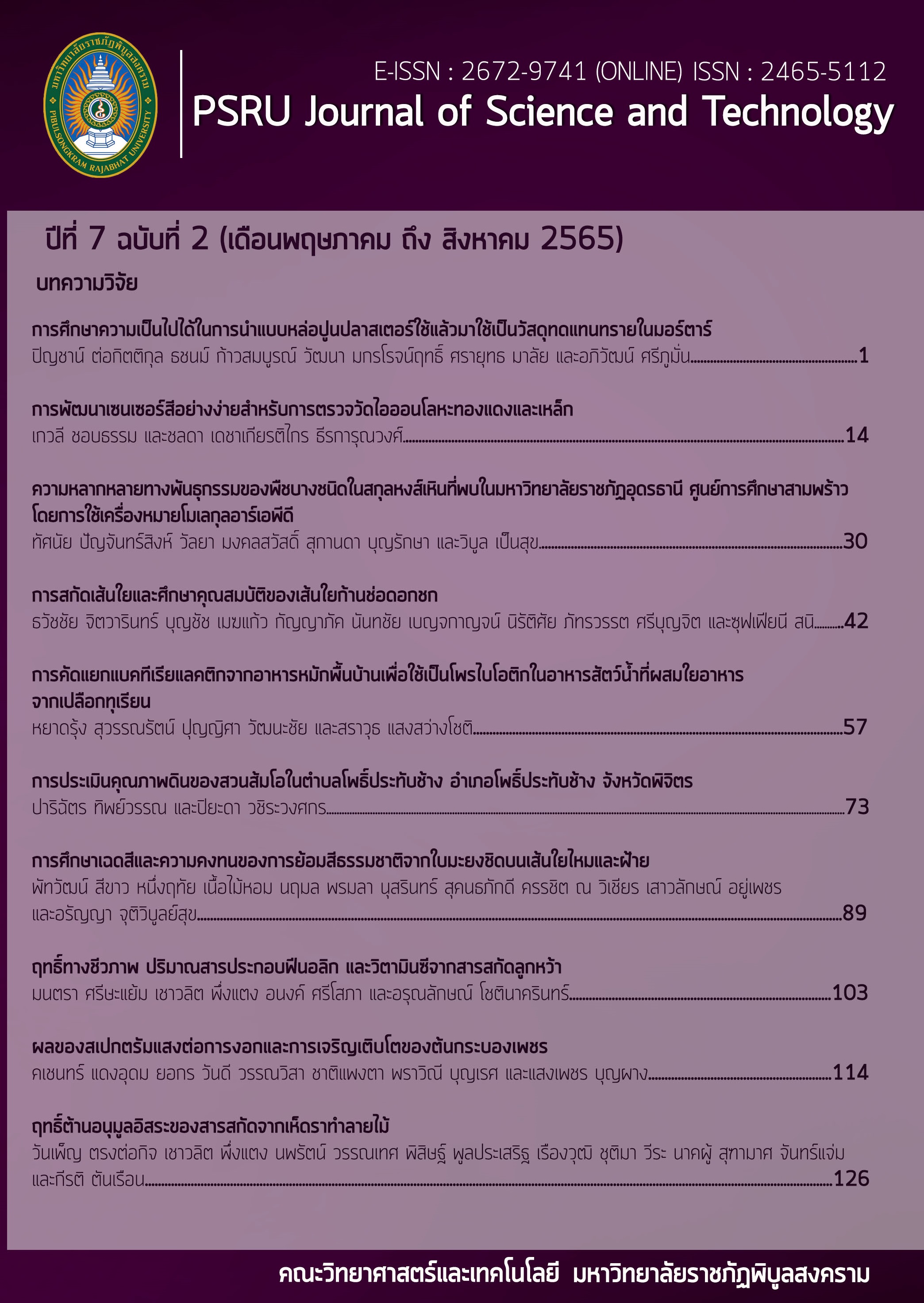ANTIOXIDANT CAPACITY OF WOOD-DESTROYING FUNGI EXTRACTS
Keywords:
Wood destroying fungi, Free radicals, Antioxidant, Bioactive compoundsAbstract
This research study aimed to evaluate the antioxidant activity of wood destroying fungi extracts. The 13 wood destroying fungi (NK0001, NK0049, NK0182, NK0317, NW1820, NW1821, NW1826, NW1836, NW1838, NW1842, NW1847, NW1850, and NW1851) obtained from the Center of Excellence in Microbial Diversity and Suitable Utilization, Chiang Mai University, Chiang Mai. All fungal isolates were cultured on Potato Dextrose Broth (PDB) for 14 days, then the mycelium was filtered and dried in hot air oven (45 °C). Dry mycelium was separately extracted by maceration with ethanol for 48 hours, filtered and adjusted to 10 mL with ethanol. The antioxidant properties of extracts based on 2,2-Diphenyl-1-picrylhydrazyl (DPPH) free radical scavenging capacity assay were analyzed. The result found that the wood destroying fungi extract (1000 ug/ml) could inhibit free radical among 5.47-90.06 %.The effective strains that indicated as high antioxidant activity (percent inhibition >50) were NW1851 (90.06%), NK001 (78.86%), NW1836 (69.12%), NW1842 (67.48%), NW1826 (62.81%), and NW1820 (59.68%). The highest antioxidant activity of the six isolates was NW1851 (IC50 value = 39.96 µg/ml). Furthermore, Total phenolic, total flavonoid and total tannin contents were also determined. The highest total phenolic and total tannin contents were found in the extract of NW1851 (2.17 mg GAE/g extract and 1.34 mg TAE/g extract, respectively). Whereas, the extract of NK0049 exhibited the highest content of flavonoid (1.20 mg QE/g extract). This research indicates that wood-destroying fungi have antioxidant activity that could be used to develop products in the food, pharmaceutical, and cosmetic industries in the future.
References
น้ำฝน เบ้าทองคำ, และถนอมนวล พรหมบุญ. (2556). การศึกษาสารต้านอนุมูลอิสระและปริมาณสารฟีนอลิกทั้งหมดของเห็ดป่าจากป่าชุมชนบ้านน้ำจาง จังหวัดเพชรบูรณ์. (วิทยานิพนธ์ปริญญามหาบัณฑิต). มหาวิทยาลัยราชภัฏเพชรบูรณ์, สาขาวิชาชีววิทยา.
บุหรัน พันธุ์สวรรค์. (2556). อนุมูลอิสระ สารต้านอนุมูลอิสระ และการวิเคราะห์ฤทธิ์ต้านอนุมูลอิสระ. วารสารวิทยาศาสตร์และเทคโนโลยี, 21(3), 275-286.
พรพิมล กิจวิชา. (2558). การศึกษาฤทธิ์การต้านอนุมูลอิสระของสารสกัดหยาบพอลิแซ็กคาไรด์จากเส้นใยของเชื้อเห็ดตับเต่า. (ปัญหาพิเศษปริญญาวิทยาศาสตรบัณฑิต). โครงการจัดตั้งภาควิชาเคมี คณะศิลปะศาสตร์และวิทยาศาสตร์ มหาวิทยาลัยเกษตรศาสตร์.
ภาวดี ช่วยเจริญ. (2561). การศึกษาผลของการต้มต่อฤทธิ์ต้านอนุมูลอิสระและสารประกอบฟีนอลิครวมในเห็ดออรินจิ เห็ดหูหนูดำ เห็ดนางฟ้า และเห็ดหอม. ใน การประชุมวิชาการและนำเสนอผลงานวิจัยระดับชาติและนานาชาติ ครั้งที่ 6 (น.382-390). กรุงเทพฯ: มหาวิทยาลัยเกษตรศาสตร์.
สุทธิดา วิทนาลัย. (2565). ฤทธิ์ทางชีวภาพและฟีนอลิกของสารสกัดเมล็ดของสารสกัดเมล็ดและเปลือกของลางสาด. PSRU Journal of Science and Technology, 7(1), 83-99.
โอภา วัชระคุปต์, บังอร วงศ์รักษ์, และศศิลักษณ์ ปยะสุวรรณ. (2550). สารต้านอนุมูลอิสระ. (พิมพ์ครั้งที่ 2). กรุงเทพฯ: นิวไทยมิตรการพิมพ์.
Chandra, P., Arora, D.S., Pal, M., & Sharma, R.K. (2019). Antioxidant potential and extracellular auxin production by white rot fungi. Appl. Biochem. Biotechnol., 187(2), 531-539.
Ganesan, V., Hariram, M., Vivekanandhan, S., & Muthuramkumar, S. (2020). Periconium sp. (endophytic fungi) extract mediated sol-gel synthesis of ZnO nanoparticles for antimicrobial and antioxidant applications. Mater. Sci. Semicond. Process., 105, 104739.
Halliwell, B., & Gutteridge, J.M.C. (2003). Free radicals in biology and medicine. U.K : Oxford university Press.
Hameed, A., Hussain, S.A., Yang, J., Ijaz, M.U., Liu, Q., Suleria, H., & Song, Y. (2017). Antioxidants potential of the filamentous fungi (Mucor circinelloides). Nutrients, 9(10), 1101.
Tavares, D.G., Barbosa, B.V.L., Ferreira, R.L., Duarte, W.F., & Cardoso, P.G. (2018). Antioxidant activity and phenolic compounds of the extract from pigment-producing fungi isolated from Brazilian caves. Biocatal. Agric. Biotechnol., 16, 148-154.
Vaz, J.A., Barros, L., Martins, A., Morais, J.S., Vasconcelos, M.H., & Ferreira, I.C.F.R. (2011). Phenolic profile of seventeen Portuguese wild mushrooms. LWT - Food Sci. Technol., 44(1), 343-346.
Downloads
Published
How to Cite
Issue
Section
License
Copyright (c) 2022 PSRU Journal of Science and Technology

This work is licensed under a Creative Commons Attribution-NonCommercial-NoDerivatives 4.0 International License.
กองบรรณาธิการขอสงวนสิทธิ์ในการปรับปรุงแก้ไขตัวอักษรและคำสะกดต่างๆ ที่ไม่ถูกต้อง และต้นฉบับที่ได้รับการตีพิมพ์ในวารสาร PSRU Journal of Science and Technology ถือเป็นกรรมสิทธิ์ของคณะวิทยาศาสตร์และเทคโนโลยี มหาวิทยาลัยราชภัฏพิบูลสงคราม และ
ผลการพิจารณาคัดเลือกบทความตีพิมพ์ในวารสารให้ถือมติของกองบรรณาธิการเป็นที่สิ้นสุด







